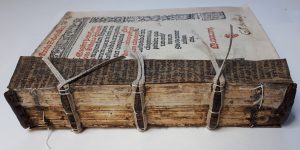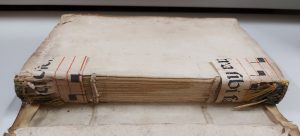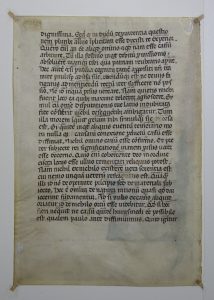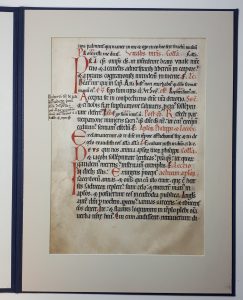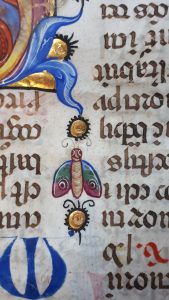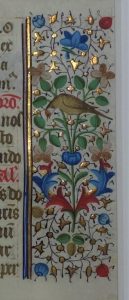Conserving a magical menagerie: the conservation and rehousing of the European Manuscripts collection

Written by Victoria Stevens, ACR
The existence of manuscript fragment collections represents a fascinating snapshot of cultural and political points in history, showing the changing attitude and purpose of these beautiful objects over time. Although originally bound, the manuscript textblocks became separated into individual leaves or pairs of leaves, known as bifolia, when their intended use became obsolete. The most significant moment of obsolescence was the Reformation which saw the widespread dissemination and destruction of manuscript codices, out-moded and out of step with the new religion. However, the existence of some fragments may be as a result of the natural deterioration of the binding through poor handling, material weakness or misuse. Once separated, text fragments of manuscripts may often be found as structural elements in bindings, with plainer items used as spine linings, covers and as reinforcements for endpapers.
More colourful fragments were often kept as full leaves as decorative art items in their own right, and one such collection is the European Manuscripts Collection held by the University of Reading Special Collections.
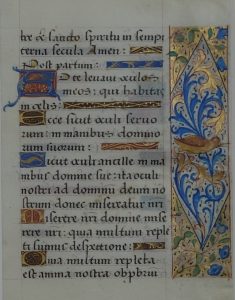
This collection of 143 items, including two bound volumes, dates from between the twelfth and the seventeenth centuries and consists of predominantly French manuscript items on parchment. French manuscripts are associated with a very fine, delicate and complex artwork style, often realistic rather than representative, and using a wide colour palette of natural pigments and embellished with metallic foils. The manuscript fragments held by the University of Reading Special Collections confirm this, and many are objects of incredible beauty, with assorted creatures – some magical, some more commonplace – dancing along the edges of the text. The charm of these objects can be instantly appreciated: the decorative marginalia delight, engage and amaze with their complexity and artistic skill.

From a conservation perspective, these items are difficult to manage. Parchment, a type of dried, stretched animal skin, is very susceptible to environmental changes and if stored incorrectly, the contraction and expansion of the skin may cause media deterioration such as cracking and loss. The metal foils, usually applied over a pigment ground to give a raised or cushioned effect, are very susceptible to being abraded and are often cracked and flaking. Thickly applied pigments are also easily detached from the stiff parchment. Keeping the fragments supported during use and restricting handling whilst still enabling them to be accessed for research and display was one of the main considerations when the collection was selected for conservation and rehousing in 2020.
Getting the balance right between conservation, or the active stabilisation of an item, and preservation, or the stabilisation of an item through its environment, storage and handling, on the one hand and facilitating access is always the focus for conservators working with written heritage materials. Previously the collection had been stored in hinged window mounts. Made of board, these were good at protecting the fragments from handling and whilst stored in stacks in boxes but the tab attachments between the objects and the mount were made of incorrect materials by current standards and were also starting to fail. The window apertures were often shaped or sized so as to cause pressure on the object below, and in many cases did not support the parchment sufficiently well. They also took up a large amount of space, something that is always in short supply in archive repositories.
The solution for the European Manuscript collection was fasciculing. Developed by the Bodleian Library in the late 1980s, fascicules are a soft paper bindings of around 15 leaves, with compensation stubs to accommodate any inserted items. Items are attached to the leaves with a Japanese paper hinge, pasted to the reverse side of the item by a narrow margin using a light application of readily reversible wheat starch adhesive. This enables the items to be fixed into the binding but released easily, and without damage, by trained staff. The fascicules are ordered according to manuscript size and several fascicules are stored in one box, making them very space efficient. The fragments are able to be produced in small numbers and, by using the supporting pages to turn the leaves, are fully and closely accessible without the need to handle the original material. The following video shows the process of attaching the Japanese paper guards to one of the fragments.
In terms of interventive conservation, the main task was to remove the existing tapes that fixed the fragments into the original window mounts. This required careful lifting of the self-adhesive tape and cleaning any sticky residues with a specific type of eraser to lift away the adhesive without damage to the parchment below. In some cases, gummed tape had been used to reinforce and repair the edges of the fragments. This required painstaking removal, a three stage process where the adhesive is softened, the carrier tape lifted and the adhesive residue removed with a very lightly damped cotton wool swab. The following videos show this delicate procedure:
With regards to overall condition, the fragments were in excellent shape and wore their great age very lightly, requiring little cleaning, flattening and repair, making them almost wholly complete and original: a rare and wonderfully rich marginal menagerie, returned to life through conservation.
